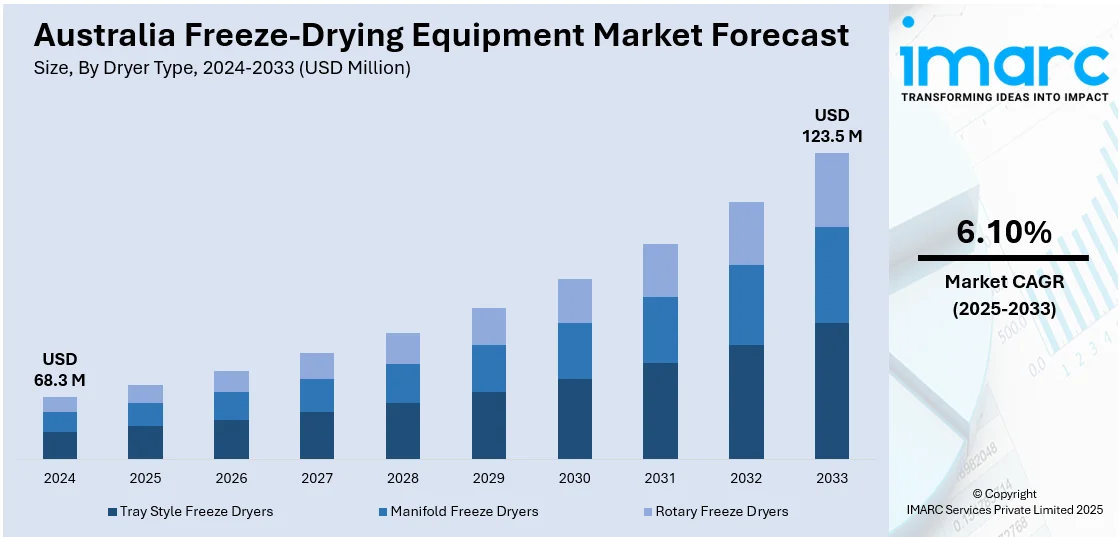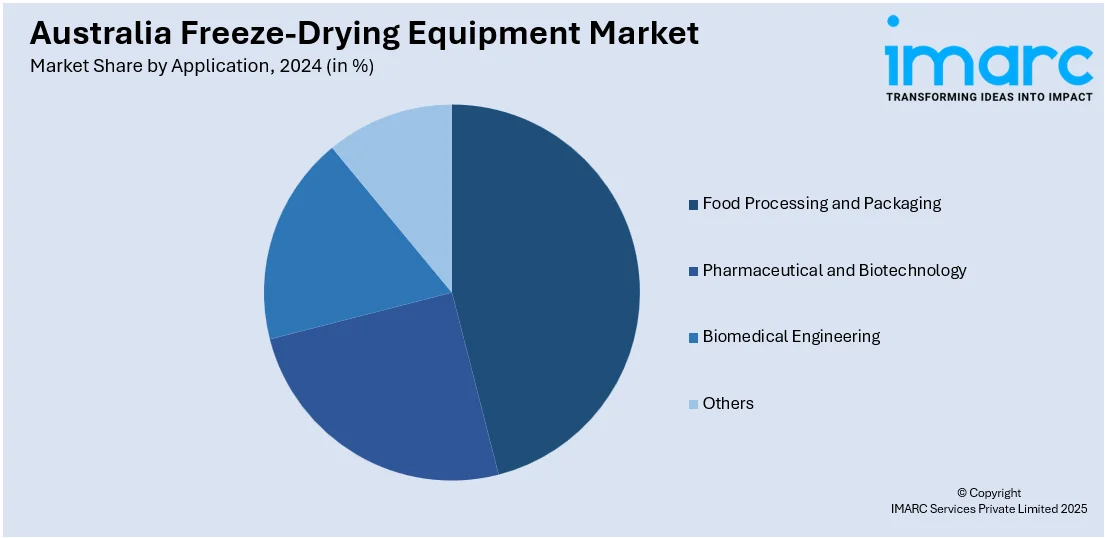
Australia Freeze-Drying Equipment Market Size, Share, Trends and Forecast by Dryer Type, Scale of Operation, Application, and Region, 2025-2033
Australia Freeze-Drying Equipment Market Overview:
The Australia freeze-drying equipment market size reached USD 68.3 Million in 2024. Looking forward, IMARC Group expects the market to reach USD 123.5 Million by 2033, exhibiting a growth rate (CAGR) of 6.10% during 2025-2033. The market share is expanding, driven by increasing investments in advanced tools that support efficient and sterile freeze-drying processes, along with rising export activities, which are creating the need for reliable solutions to preserve items.
|
Report Attribute
|
Key Statistics
|
|---|---|
|
Base Year
|
2024 |
|
Forecast Years
|
2025-2033
|
|
Historical Years
|
2019-2024
|
| Market Size in 2024 | USD 68.3 Million |
| Market Forecast in 2033 | USD 123.5 Million |
| Market Growth Rate 2025-2033 | 6.10% |
Australia Freeze-Drying Equipment Market Trends:
Growing applications in pharmaceutical industry
Rising applications in the pharmaceutical industry are offering a favorable Australia freeze-drying equipment market outlook. As more drug producers are focusing on providing high-quality and long-lasting items, freeze-drying is becoming a popular method for maintaining the stability and efficacy of delicate medications. It is particularly beneficial for vaccinations, biologics, and injectable medications that must be stored for extended periods without losing effectiveness. As the pharmaceutical sector is thriving in response to the increasing healthcare demands, expenditure on modern equipment that enables efficient and sterile freeze-drying processes is rising. The freeze-drying method is also used in research laboratories and biotech companies to handle sensitive materials, such as proteins and enzymes. Because the technique eliminates water without requiring high temperatures, it is ideal for heat-sensitive materials. The growing emphasis on generating and keeping vaccines and other important pharmaceuticals locally is promoting the employment of dependable freeze-drying devices. Furthermore, the rising demand for better drug packaging and transportation across great distances in Australia's extensive geography is making freeze-dried formats more appealing. As the pharmaceutical industry is burgeoning and utilizing high-quality formulations, the requirement for freeze-drying equipment is growing. As per the IMARC Group, the Australia pharmaceutical market is set to attain USD 31.1 Billion by 2033, showing a CAGR of 2.60% from 2025-2033.

Rising export activities
The increasing export activities are fueling the Australia freeze-drying equipment market growth. According to the CEIC, in December 2024, Australia's total exports reached USD 27.9 Billion. As local producers look to enter international markets, especially in food and beverage (F&B), pharmaceutical, and biotech, they need reliable ways to preserve item quality during long-distance shipping. Freeze-drying aids by removing moisture while keeping the structure, nutrients, and effectiveness of the product intact. Whether it is for exporting powdered food products, ready-to-use meals, or temperature-sensitive medical supplies, this method ensures items stay shelf-stable and safe even without refrigeration. With the rising demand from regions like Asia and North America for high-quality Australian goods, more companies are investing in freeze-drying equipment to meet export standards. These systems help to improve packaging efficiency, reduce spoilage, and extend item life, all of which are crucial when sending goods abroad. Moreover, many international markets have strict regulations about quality and preservation, and freeze-dried products often meet those requirements better.
Australia Freeze-Drying Equipment Market Segmentation:
IMARC Group provides an analysis of the key trends in each segment of the market, along with forecasts at the regional level for 2025-2033. Our report has categorized the market based on dryer type, scale of operation, and application.
Dryer Type Insights:
- Tray Style Freeze Dryers
- Manifold Freeze Dryers
- Rotary Freeze Dryers
The report has provided a detailed breakup and analysis of the market based on the dryer type. This includes tray style freeze dryers, manifold freeze dryers, and rotary freeze dryers.
Scale of Operation Insights:
- Industrial Scale Freeze Dryer
- Pilot Scale Freeze Dryer
- Laboratory Scale Freeze Dryer
A detailed breakup and analysis of the market based on the scale of operation have also been provided in the report. This includes industrial scale freeze dryer, pilot scale freeze dryer, and laboratory scale freeze dryer.
Application Insights:

- Food Processing and Packaging
- Pharmaceutical and Biotechnology
- Biomedical Engineering
- Others
The report has provided a detailed breakup and analysis of the market based on the application. This includes food processing and packaging, pharmaceutical and biotechnology, biomedical engineering, and others.
Regional Insights:
- Australia Capital Territory & New South Wales
- Victoria & Tasmania
- Queensland
- Northern Territory & Southern Australia
- Western Australia
The report has also provided a comprehensive analysis of all the major regional markets, which include Australia Capital Territory & New South Wales, Victoria & Tasmania, Queensland, Northern Territory & Southern Australia, and Western Australia.
Competitive Landscape:
The market research report has also provided a comprehensive analysis of the competitive landscape. Competitive analysis such as market structure, key player positioning, top winning strategies, competitive dashboard, and company evaluation quadrant has been covered in the report. Also, detailed profiles of all major companies have been provided.
Australia Freeze-Drying Equipment Market News:
- In February 2025, MedTEC Pharma, based in South Australia, emerged as one of the initial Australian companies to manufacture freeze-dried items from plants cultivated locally. The firm spent a significant amount of money on innovative post-harvesting technologies for creating live rosin vapes, freeze-dried live flower, and live rosin gummies. The funding enabled the company to obtain a large-scale freeze dryer from New Zealand and cryo-trimming machinery from the United States.
- In August 2024, Pfizer announced the broadening of its pharmaceutical manufacturing facility in Melbourne, Australia. The firm spent AUD 150 Million on developing new antimicrobial therapies designed to tackle increasing antimicrobial resistance levels. The investment encompassed the building of a new distinct plant that contained two freeze-dryers referred to as lyophilisers.
Australia Freeze-Drying Equipment Market Report Coverage:
| Report Features | Details |
|---|---|
| Base Year of the Analysis | 2024 |
| Historical Period | 2019-2024 |
| Forecast Period | 2025-2033 |
| Units | Million USD |
| Scope of the Report | Exploration of Historical Trends and Market Outlook, Industry Catalysts and Challenges, Segment-Wise Historical and Future Market Assessment:
|
| Dryer Types Covered | Tray Style Freeze Dryers, Manifold Freeze Dryers, Rotary Freeze Dryers |
| Scales of Operation Covered | Industrial Scale Freeze Dryer, Pilot Scale Freeze Dryer, Laboratory Scale Freeze Dryer |
| Applications Covered | Food Processing and Packaging, Pharmaceutical and Biotechnology, Biomedical Engineering, Others |
| Regions Covered | Australia Capital Territory & New South Wales, Victoria & Tasmania, Queensland, Northern Territory & Southern Australia, Western Australia |
| Customization Scope | 10% Free Customization |
| Post-Sale Analyst Support | 10-12 Weeks |
| Delivery Format | PDF and Excel through Email (We can also provide the editable version of the report in PPT/Word format on special request) |
Key Questions Answered in This Report:
- How has the Australia freeze-drying equipment market performed so far and how will it perform in the coming years?
- What is the breakup of the Australia freeze-drying equipment market on the basis of dryer type?
- What is the breakup of the Australia freeze-drying equipment market on the basis of scale of operation?
- What is the breakup of the Australia freeze-drying equipment market on the basis of application?
- What is the breakup of the Australia freeze-drying equipment market on the basis of region?
- What are the various stages in the value chain of the Australia freeze-drying equipment market?
- What are the key driving factors and challenges in the Australia freeze-drying equipment market?
- What is the structure of the Australia freeze-drying equipment market and who are the key players?
- What is the degree of competition in the Australia freeze-drying equipment market?
Key Benefits for Stakeholders:
- IMARC’s industry report offers a comprehensive quantitative analysis of various market segments, historical and current market trends, market forecasts, and dynamics of the Australia freeze-drying equipment market from 2019-2033.
- The research report provides the latest information on the market drivers, challenges, and opportunities in the Australia freeze-drying equipment market.
- Porter's five forces analysis assist stakeholders in assessing the impact of new entrants, competitive rivalry, supplier power, buyer power, and the threat of substitution. It helps stakeholders to analyze the level of competition within the Australia freeze-drying equipment industry and its attractiveness.
- Competitive landscape allows stakeholders to understand their competitive environment and provides an insight into the current positions of key players in the market.
Need more help?
- Speak to our experienced analysts for insights on the current market scenarios.
- Include additional segments and countries to customize the report as per your requirement.
- Gain an unparalleled competitive advantage in your domain by understanding how to utilize the report and positively impacting your operations and revenue.
- For further assistance, please connect with our analysts.
 Inquire Before Buying
Inquire Before Buying
 Speak to an Analyst
Speak to an Analyst
 Request Brochure
Request Brochure
 Request Customization
Request Customization




.webp)




.webp)












